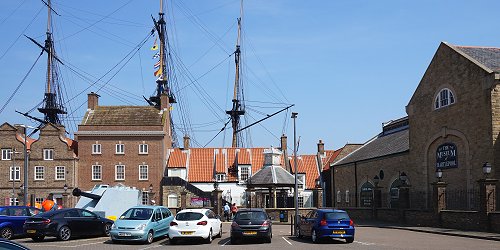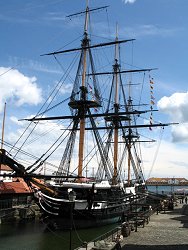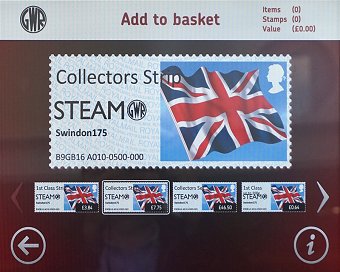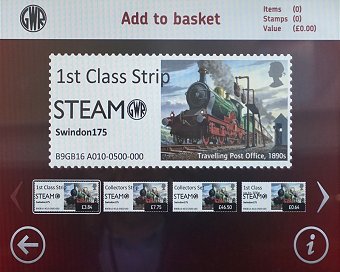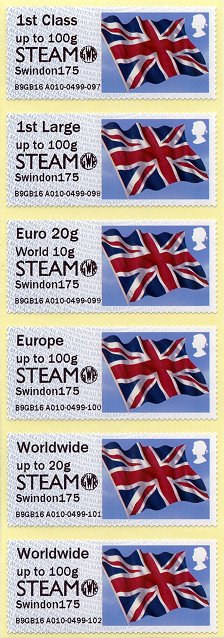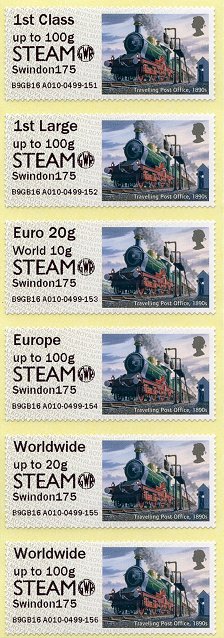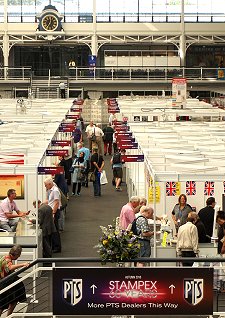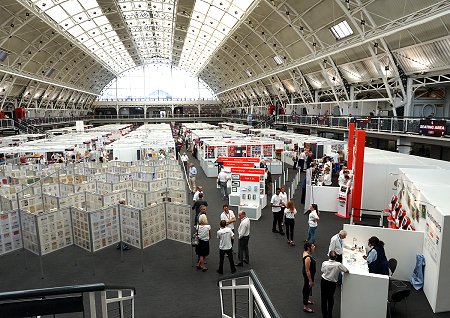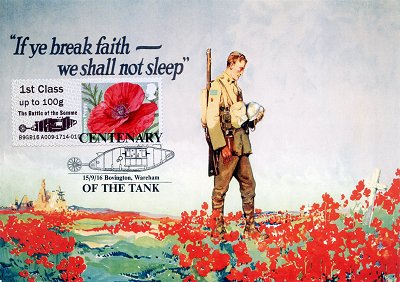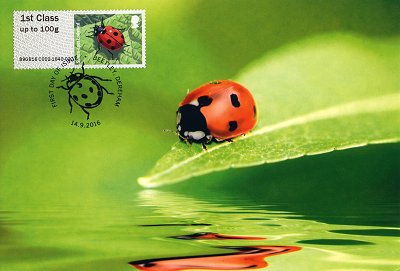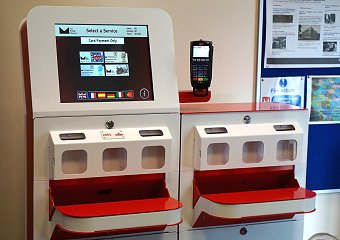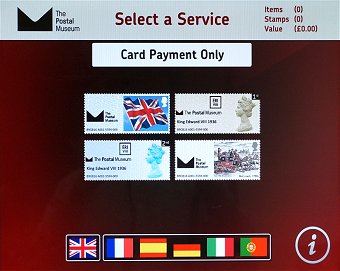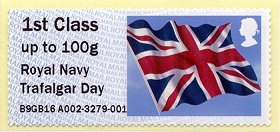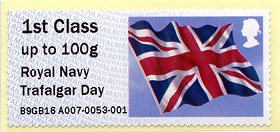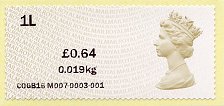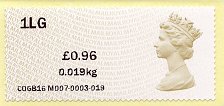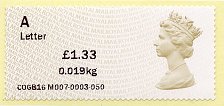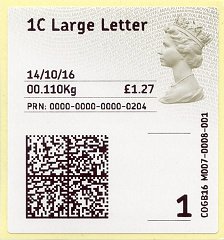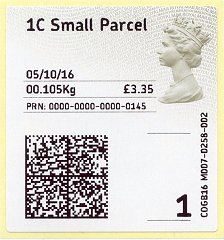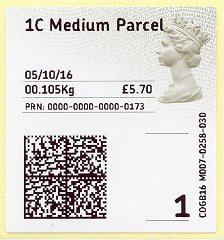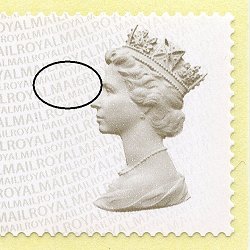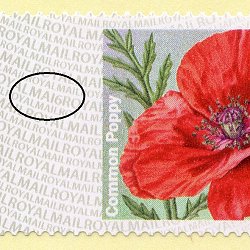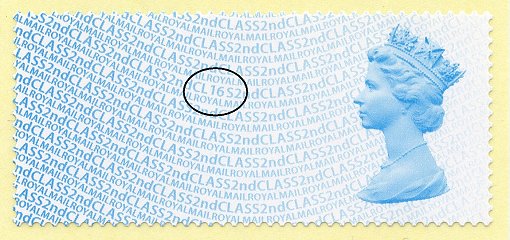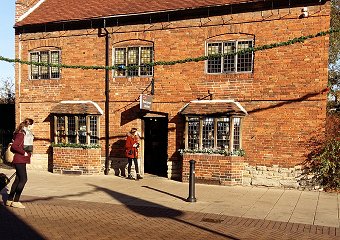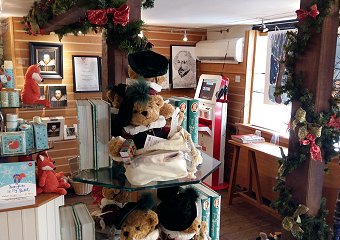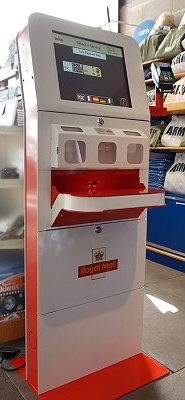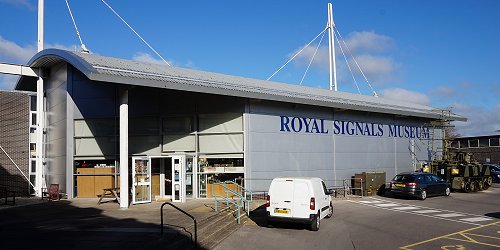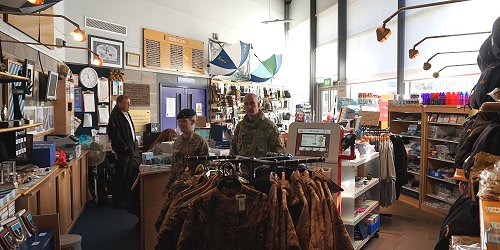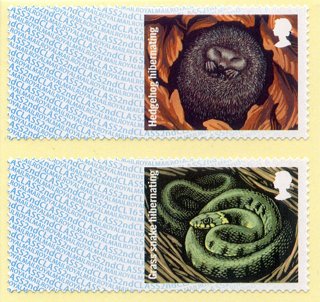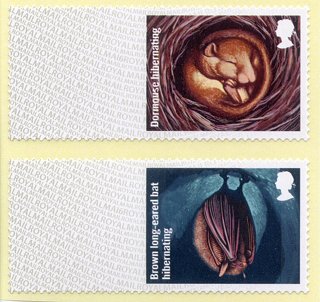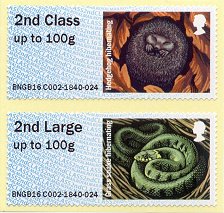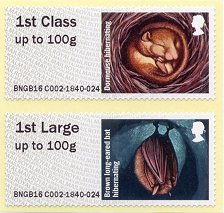| UNITED KINGDOM. 2016, the Post&Go issues (2) |
|
 |
| Royal Mail marks the Battle of Jutland centenary |
The Battle of Jutland was the largest naval battle of the First World War. On May 31st and June 1st, 1916, the fleets of the Imperial German Navy and the British Royal Navy fought in the North Sea, near the coast of Denmark's Jutland peninsula. To commemorate the centenary of this important battle, Royal Mail programmed the 'Battle of Jutland' special imprint into all the postal kiosks installed at the museums that are part of The National Museum of the Royal Navy.
This special imprint was available for a month, from May 31st to June 30th 2016, on all the stamps with the 'Machin' and 'Union flag' definitive designs, issued by these kiosks.
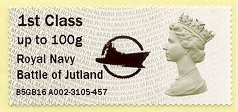 |
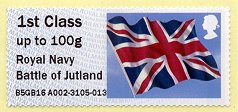 |
A002 - The National Museum of the Royal Navy, Portsmouth |
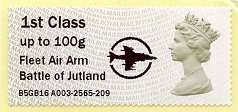 |
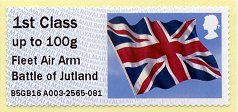 |
A003 - The Fleet Air Arm Museum, Ilchester |
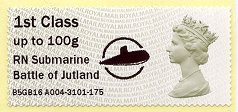 |
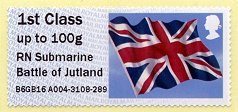 |
A004 - The Royal Navy Submarine Museum, Gosport |
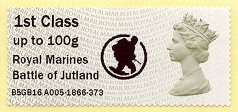 |
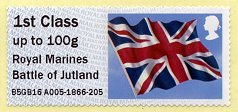 |
A005 - The Royal Marines Museum, Southsea |
From June 1st 2016, it was also available from the last two named kiosks installed in Royal Navy museums, although, in both cases, the name of the museum is not printed on the stamps. Instead of this, Royal Mail decided to just use the identifier 'Royal Navy' (see next section).
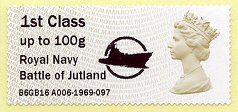 |
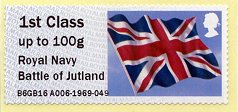 |
A006 - HMS Trincomalee, Hartlepool |
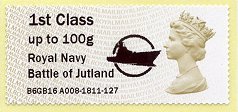 |
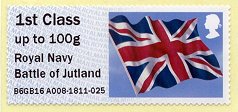 |
A008 - HMS Caroline, Belfast |
| Two new postal kiosks in Royal Navy museums |
After the machine was installed at Gosport's Royal Navy Submarine Museum, in July 2015, (see article, also published in VARIABLE 38), Royal Mail decided to install another two kiosks at small museums that are also part of The National Museum of the Royal Navy, - HMS Trincomalee and HMS Caroline.
Unlike the stamps issued by the rest of the kiosks, the variable value stamps, printed by these two machines, do not include the explicit name of the museum, but the general 'Royal Navy' identifier and logo, as with the machine A002 installed at Portsmouth's National Museum of the Royal Navy. Only the kiosk number in the bottom code defines the origin of the stamp.
The HMS Trincomalee is a Leda class sailing frigate with 46 guns. Built in 1816-17 by the East India Company in Bombay, it is the only surviving Royal Navy ship built in India, and the oldest surviving battleship in the United Kingdom.
The ship was in service until 1986. In 1987, the HMS Trincomalee Trust began the restoration of the frigate, which ended in 2001.
The ship is the main focus of Hartlepool's Maritime Experience, a small museum located in Hartlepool, in the north-east of England, showing a re-creation of an 18th century harbour. Since June 2014, the museum became part of The National Museum of the Royal Navy. |
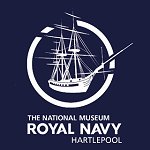 |
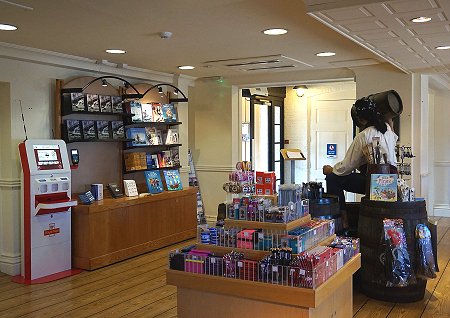 |
Like other museums, the Royal Mail kiosk is installed in the shop. Although very well located ... it is difficult to justify from a strictly postal point of view, bearing in mind that the museum receives an average of just over 4,000 visitors per month. |
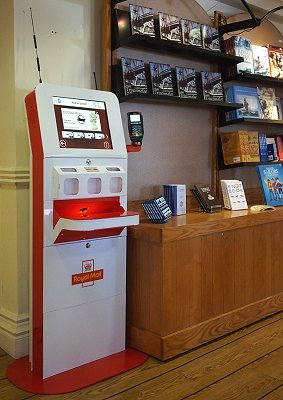 |
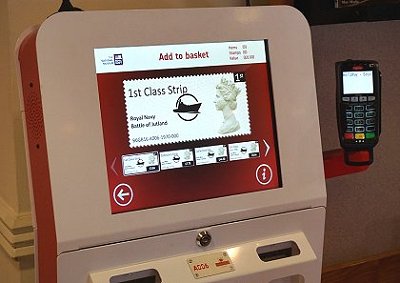 |
| This is the A006 machine, first introduced at London Spring Stampex 2015, and later used, temporarily, at various national and international philatelic events. |
| On the date of installation, June 1st 2016, and when in normal service, the kiosk issues stamps with the 'Machin' and 'Union flag' definitive designs. |
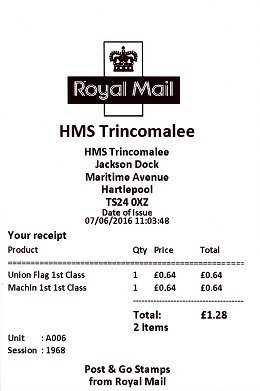 |
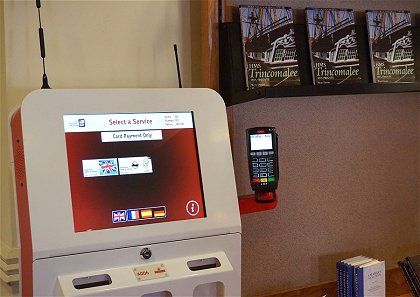 |
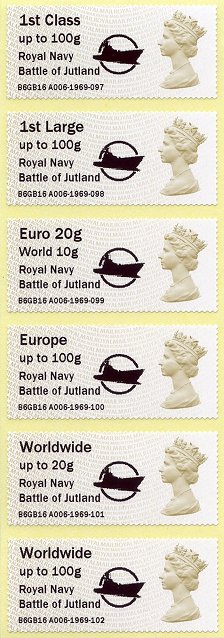 |
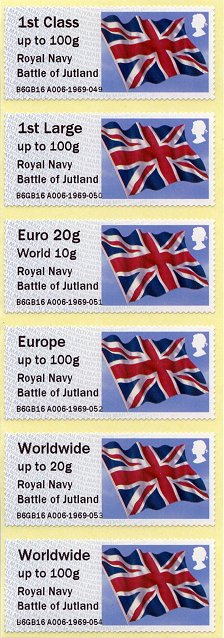 |
During the first month in operation, and until June 30th, the kiosk issued the stamps with the 'Battle of Jutland' special overprint, along with the other equipment installed in the museums that are part of The National Museum of the Royal Navy.
From July 1st 2016, the stamps include only the general 'Royal Navy' identifier and the logo (only on the 'Machin' stamps). |
| HMS Caroline is a C-class light cruiser of the Royal Navy. Built in 1914, it participated in the Battle of Jutland, and is one of only three surviving Royal Navy warships of the First World War. During World War II, the ship was used as an administrative centre, and then continued as a floating training establishment until its decommissioning, in 2011. |
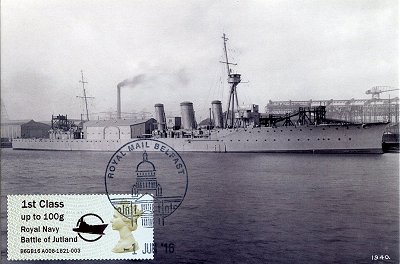 |
After a major restoration, the ship has been transformed into a museum, integrated into the museum network of The National Museums of the Royal Navy.
It is moored at Alexandra Dock, in Belfast, Northern Ireland, in the same shipyard where the Titanic was built. It complements a group of maritime attractions that are currently being developed at the docks of the former Belfast shipyards, including the great Titanic Belfast Museum. |
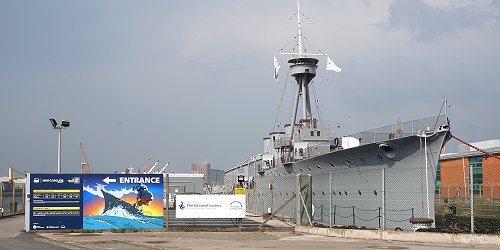 |
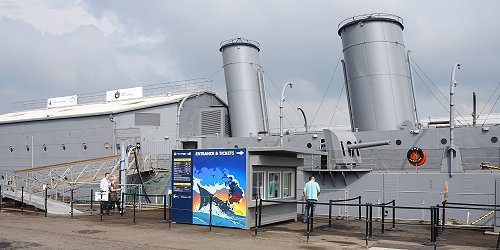 |
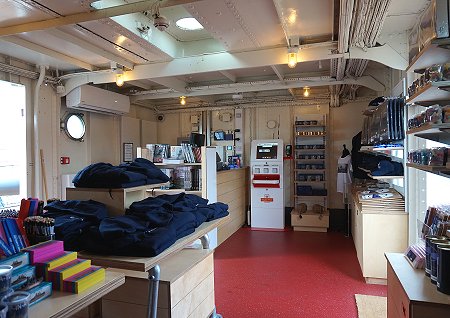 |
HMS Caroline was opened to the public on June 1st 2016, coinciding with the centenary of the Battle of Jutland. The Royal Mail postal kiosk came into service from that same day, at the museum's souvenir shop. At present, the museum only includes the ship and a small temporary pavilion on the dock, for ticket sales, so the shop -and the kiosk- are presently inside the ship. |
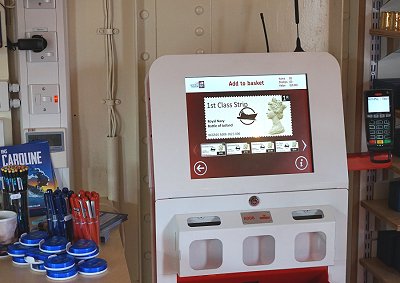 |
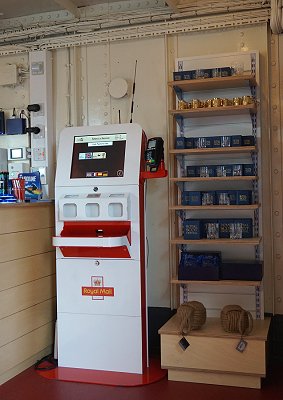 |
| The machine installed on board the HMS Caroline is number A008, first launched at the Perth's 86th Scottish Congress, in 2015, and then temporarily used at various national and international philatelic events. |
| On the date of installation, June 1st 2016, and on a regular basis, the kiosk issues stamps with the two definitive designs, 'Machin' and 'Union flag'. |
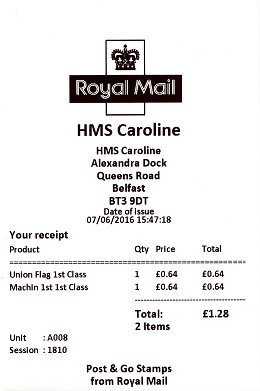 |
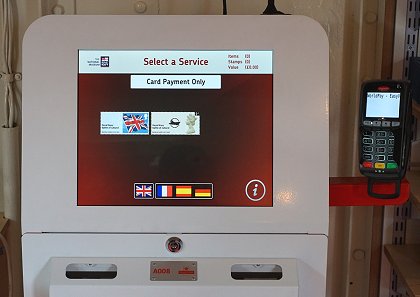 |
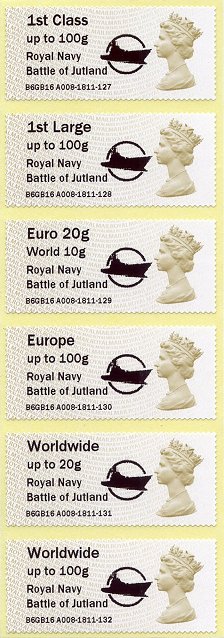 |
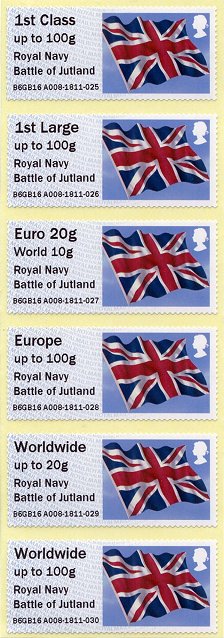 |
Just as with the machine installed in the HMS Trincomalee, and during the first month in operation, kiosk A008 issued the stamps with the 'Battle of Jutland' special overprint, like the rest of the kiosks installed in those museums that are part of The National Museum of the Royal Navy.
From July 1st 2016, the stamps only include the 'Royal Navy' general identifier and the logo (but only on the 'Machin' stamps). |
On Saturday June 18th 2016, as part of the celebrations of the 500th anniversary of the creation of the postal service, Royal Mail organized an exhibition and various activities related to its history, in the square opposite the Guildhall, in London. Among them, an old horse-drawn carriage ride through central London. In previous weeks, the carriage toured Cardiff, Edinburgh and Belfast.
Royal Mail also installed a 'Post & Go' kiosk. Throughout the day, the A009 machine issued stamps printed on rolls of the 'Machin' design and the special imprint '500 Years of Royal Mail'. This combination was identical to those produced by the Royal Mail kiosks installed, a few months earlier, at Spring Stampex (see article, also published in VARIABLE 40). |
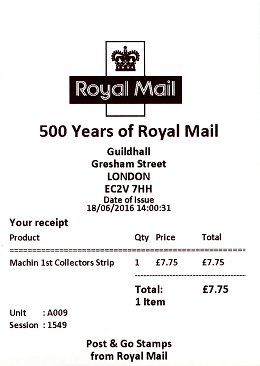 |
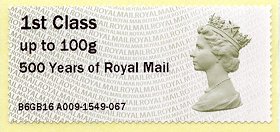 |
 |
On the occasion of the participation of the United Kingdom, in the Rio de Janeiro Olympic Games, Royal Mail decided to replace, temporarily, the rolls of 'Machin' definitive designs with the 'Union flag' design, at all kiosks installed in postal offices around the country.
This design was available from August 1st at the Royal Mail Enquiry Offices (Intelligent AR kiosks - images), from August 10th in all post offices equipped with NCR kiosks, until September 13th. |
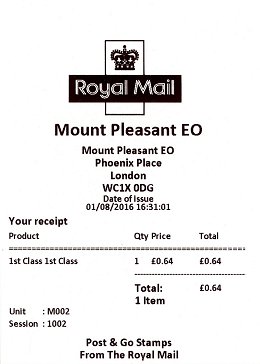 |
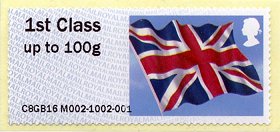 |
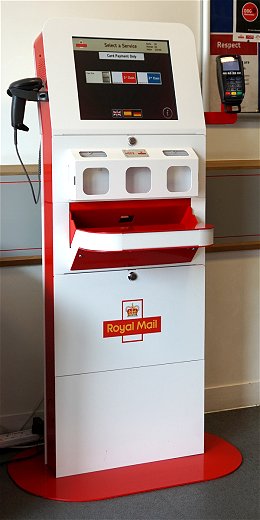 |
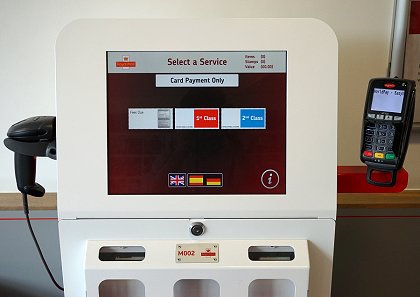 |
Since the beginning of 2016, 'Post & Go' kiosks installed in the Royal Mail Enquiry Offices no longer show, on-screen, the design of the stamps they issue, but only indications of the type of shipment, - '1st Class' and '2nd Class'.
Since these machines are primarily designed for postal and non-philatelic use, the design of the stamp is considered to be irrelevant. This change significantly simplifies the operation of the equipment, both from the point of view of the user and the maintenance, since it no longer requires the change of images appearing on the screen when introducing new label designs. |
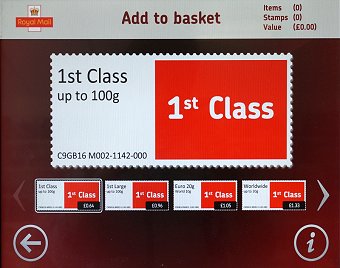 |
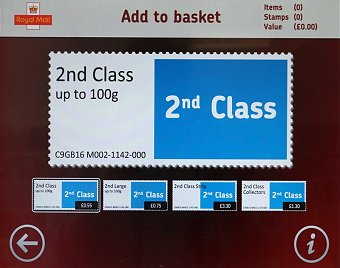 |
| The postal kiosk at Explosion! Museum |
Following the two machines installed, in June, at HMS Trincomalee and HMS Caroline, Royal Mail continues with the installation of permanent postal kiosks in another museum that is part of The Royal Museum of the Royal Navy, the Explosion! Museum, in Gosport.
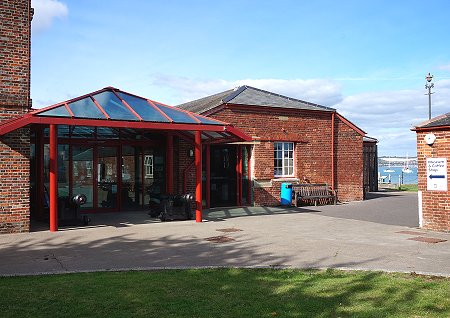 |
Explosion! is a naval warfare museum housed in various buildings around an original 18th century powder magazine, in Priddy's Hard, Gosport, a few miles north of The Royal Navy Submarine Museum.
The museum shows the development of naval armament from gunpowder to modern missiles, as well as the history of the complex of Priddy's Hard buildings. |
| Also installed in the museum shop is the brand-new A007 kiosk, started up on August 16th 2016 which issues stamps with the two usual definitive designs, 'Machin' and 'Union flag'. |
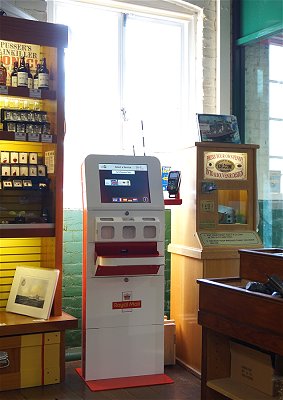 |
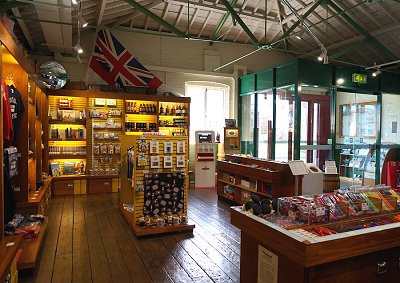 |
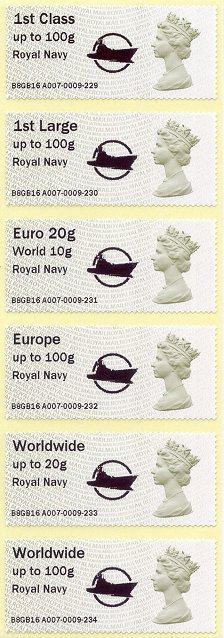 |
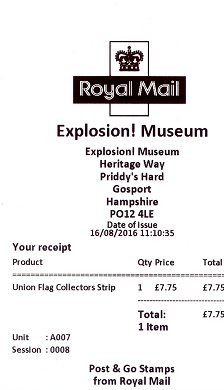 |
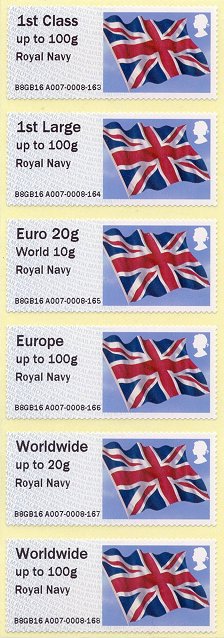 |
| This machine also issues the stamps with the general 'Royal Navy' identifier and logo. Then, from August 16th 2016, four kiosks (A002, A006, A007 and A008) have the same impression. Only the machine number printed on the code at the bottom of the stamp defines the origin of the stamp. |
With just a few dozen visitors to the museum each day, the kiosk is scarcely used for 'real' stamp sales, as shown by the session number printed on stamps and receipts. In short, another bizarre Royal Mail decision, without any justification from a postal point of view. The machine is there just waiting for some 'philatelic change' that will attract, from time to time, collectors and dealers, who, otherwise, would be little interested in a kiosk that issues stamps almost identical to other machines.
On September 13th 1840, Sir Daniel Gooch (right image), locomotive superintendent of the Great Western Railway (GWR), wrote a letter to Isambard Kingdom Brunel, the railway's chief engineer, suggesting the construction of the central repair and maintenance workshops for the new railway in the city of Swindon. This is, undoubtedly, the most important letter of the history of the city, and origin of the important development that the city had in the following years.
In the year of the 175th anniversary of Swindon's birth as a railway city, Royal Mail wanted to mark this important date with a change in the special overprint on the stamps issued by the A010 kiosk installed at STEAM – the Museum of the Great Western Railway. |
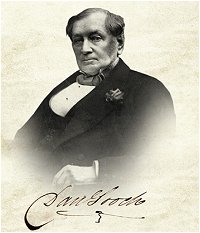 |
From February 25th 2016, the machine included the special overprint 'STEAM GWR Swindon175' on all the stamps (below, left - see article, also published in VARIABLE 40).
From September 13th, the first line changed with the introduction of the museum logo (image below, right).
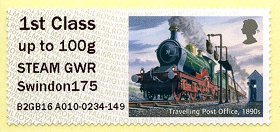 |
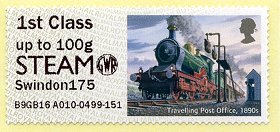 |
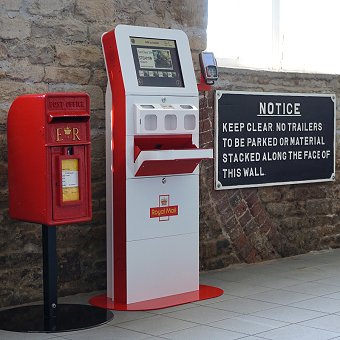 |
This new imprint was available until the end of the year, on all stamps issued by the kiosk and printed on rolls of labels with the definitive 'Union flag' and the special 'Travelling Post Office, 1890s' designs. |
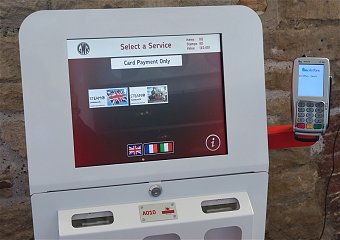 |
| The ATMs at AUTUMN STAMPEX 2016 |
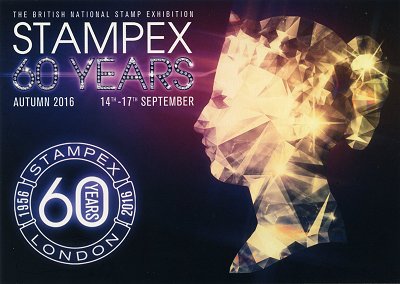 |
In a special year, which celebrates the UK's major philatelic fair’s 60th anniversary, Autumn Stampex 2016 was held from September 14th to 17th at its usual location, the Islington Business Design Centre, London.
Together with the spring fair, the biannual Stampex is organized by the Philatelic Traders' Society (PTS), with the collaboration of Royal Mail. |
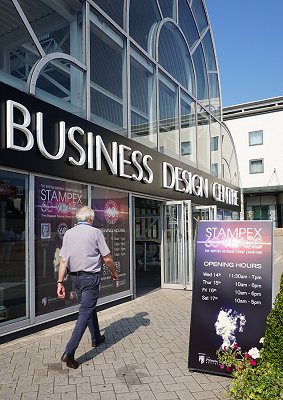 |
With very few changes, compared to previous shows, the fair brought together more than 100 stands, distributed over the two levels of the central exhibition hall and the gallery bays. The booths were mainly occupied by major international philatelic dealers, auction houses, and a few specialist publications. |
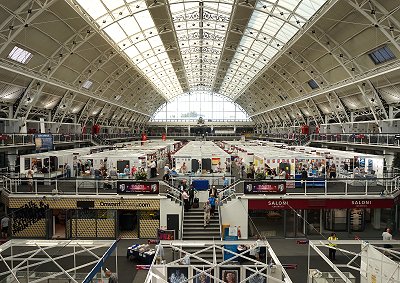 |
The Royal Mail stand was located at the back of the large exhibition hall, in front of the national philatelic exhibition, organized by The Association of British Philatelic Societies (ABPS).
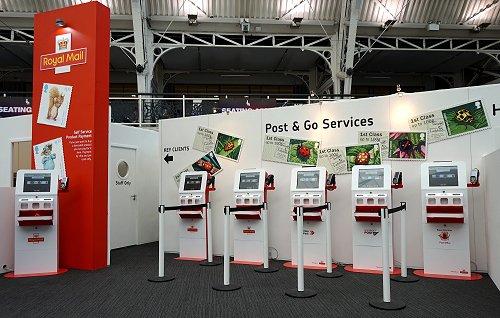 |
Unchanged from previous fairs, the 'Post & Go' equipment was part of the large Royal Mail stand, with six Intelligent AR / Royal Mail Series II philatelic kiosks. |
| In the picture, from left to right, the A012 & A014 kiosks of Royal Mail; The JE01 of Jersey Post, GG01 of Guernsey Post, and the GI01 kiosk of the Royal Gibraltar Post Office. |
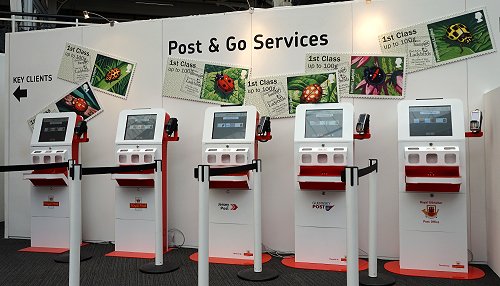 |
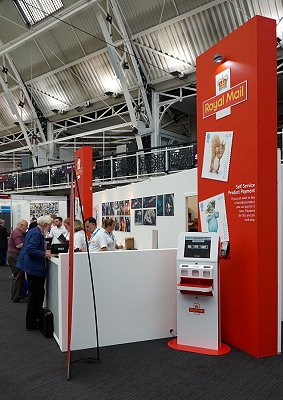 |
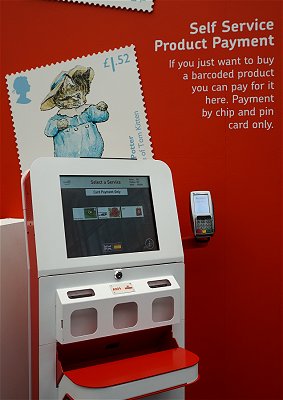 |
A third Royal Mail kiosk (A009) was installed next to the philatelic products sales counter area (images). In addition to issuing stamps, visitors could use the kiosk to pay for the various bar coded products on show in the self-service area. |
| Along with the 'Post & Go Services', Royal Mail arranged a counter for postmarking, with the special postmarks for the event. |
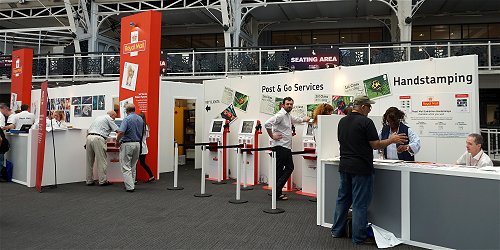 |
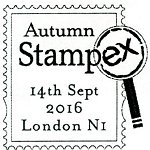 |
The usual special overprints programmed into the kiosks during Stampex were dedicated, on this occasion, to commemorate the centenary of the Battle of the Somme.
With more than one million dead or wounded, on both sides, the Battle of the Somme was one of the longest and bloodiest of the First World War. On July 1st 1916, the first day, the British army alone lost 20,000 men.
During the four days of Autumn Stampex 2016, the three kiosks A009, A012 and A014 of Royal Mail issued ATMs with the 'Common Poppy' design (issued 2015 - MA15) and the special imprint 'The Battle of the Somme' from one printer, and the new 'Ladybirds' series (see next section) from the other (screen below). |
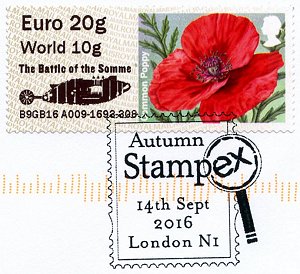 |
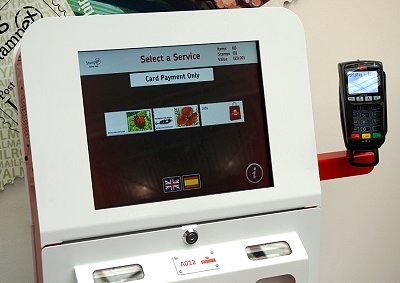 |
The special imprint includes a graphic featuring the side elevation of the Mark I, the world's first tank, used by the British Army at the Battle of Flers-Courcelette, on September 15th 1916.
Royal Mail produced a special commemorative postmark, illustrated with the same graphic (see maximum card below). |
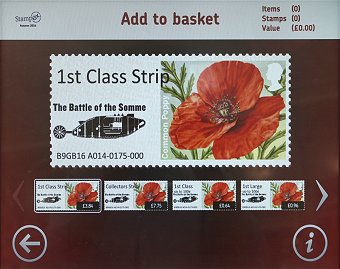 |
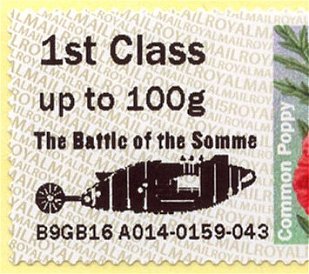 |
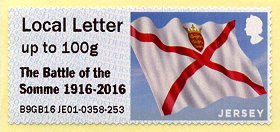 |
The Jersey Post JE01 kiosk issued ATMs with the Jersey flag definitive design and the special imprint
The Battle of the
Somme 1916-2016
on one of the rolls, and the new thematic 'Beetles' series, with no special overprint, on the other.
These issues are dealt with in more detail in the article dedicated to Jersey Post. |
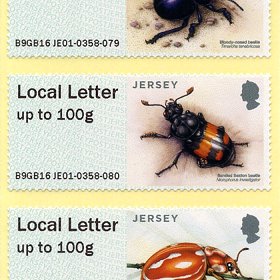 |
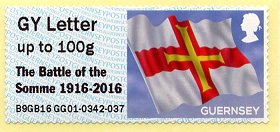 |
The Guernsey Post GG01 kiosk issued ATMs with the Guernsey flag definitive design and the special imprint
The Battle of the
Somme 1916-2016
on one of the reels, and the thematic 'Bailiwick Life' series, with no special overprint, in the other printer. It is worth noting that the rolls of labels used by this kiosks were a series reprinting, with the same designs but with no glossy finish.
These issues are dealt with in more detail in the article dedicated to Guernsey Post. |
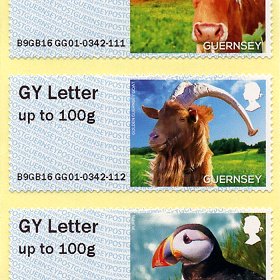 |
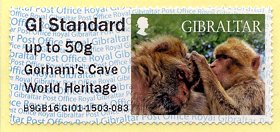 |
Unfortunately, various errors and misunderstandings merged in the Royal Gibraltar Post Office GI01 kiosk. During Stampex, the 'Gibraltar Macaques' and 'Year of the Monkey' designs were available with no special imprint, and also with the special imprint 'Gorham's Cave World Heritage'.
These issues are dealt with in more detail in the article dedicated to Royal Gibraltar Post Office. |
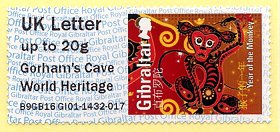 |
The first block of the code at the bottom of all the stamps issued by the six philatelic kiosks installed at the Autumn Stampex 2016, is B9GB16, followed by the machine code, transaction and stamp number. In addition to these machines, Collectors strips were printed by using the internal usage printers B001 (UK designs) and B002 (Jersey and Guernsey designs), and sold by their respective philatelic services.
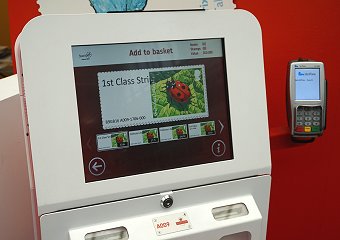 |
The second thematic 'Post & Go' series issued in 2016 was available from September 14th, coinciding with the opening of Autumn Stampex 2016. The six designs of the series features different species of ladybirds living in Britain, one of the best-loved insects. |
On the date of issue, the new series could be obtained at many of the NCR postal kiosks installed in post offices across the country, from the three Royal Mail Series II philatelic kiosks (A009, A012 & A014), installed at London Stampex (upper image) and, for the first time, from the M002 kiosk installed in the Royal Mail Mount Pleasant Enquiry Office, next to the London Postal Museum. Pre-orders were printed using the internal-use equipment, code B001.
Royal Mail released its usual presentation pack with the six designs (right image), printed by the internal-use C002 printer. |
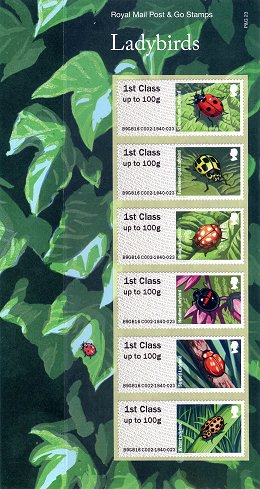 |
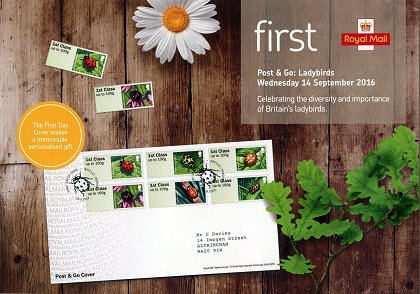 |
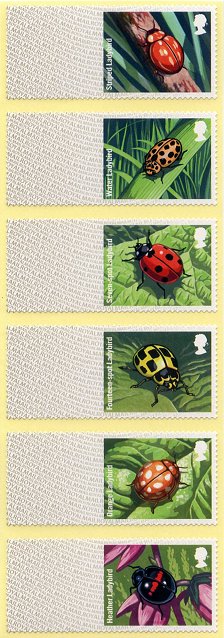 |
The new series features six ladybirds, some of them unknown to most. The seven-spot Ladybird (Coccinella septempunctata) is, probably, the most popular (see maximum card at the end of the article), the fourteen-spot ladybird (Propylea quatuordecimpunctata), the Orange Ladybird (Halyzia sedecimguttata), the Heather Ladybird (Chilocorus bipustulatus), the Striped Ladybird (Myzia oblongoguttata), and the Water Ladybird (Anisosticta novemdecimpunctata). |
The rolls of labels were manufactured by International Security Printers, and have identical characteristics to previous issues.
The beautiful illustrations are by Chris Wormell, author of the designs for the 'Freshwater life' series (2013) and the 'Heraldic Beasts' series of 2015. |
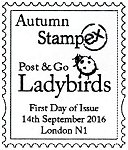 |
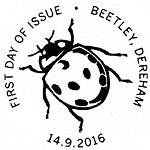 |
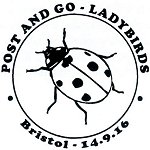 |
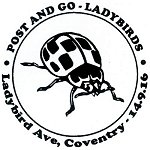 |
| First day special postmarks |
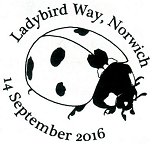 |
 |
The images below show stamp strips with the different printing varieties and the face value indicators available for this set of designs, as issued by the equipment used on the date of issue. From left to right,
(1)
the C002 printer, used for advance printing of the stamps in the presentation packs,
(2) the Intelligent AR equipment (A009, A012 & A014), in service at the Autumn Stampex 2016, and B001 for internal use,
(3) the M002 postal kiosk installed at the Royal Mail Enquiry Office (code at the bottom starting with C9GB16 ...)
(4 - Bottom row) the NCR postal kiosks.
All the stamps included in the folders have the same face value '1st Class up to 100g', and the lower identification code is the same for all the stamps - In this case, B9GB16 C002-1840-023. In the first block, B is for 'philatelic' issue, 9 is for the month of issue (September), GB for the country, and 16 for the year of issue. In the second block, C002 is the code of the printer. Then follows 1840, the usual fictitious session number (year of issue of the Penny Black), and 023 indicates the number of the pictorial series, since the beginning of the 'Post & Go' issues. |
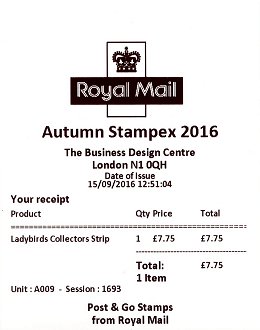 |
| Receipt for the purchase of one 'Collectors strip', the set with the six values programmed, in the A009 postal kiosk |
| C002 |
A009 - A012 - A014 - B001 |
M002 |
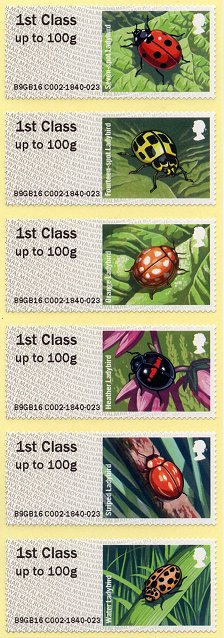 |
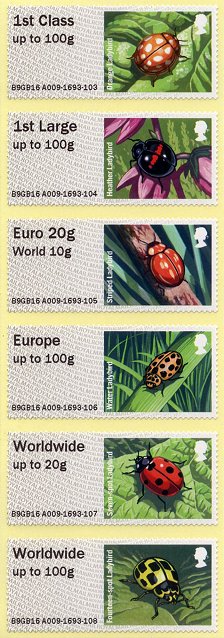 |
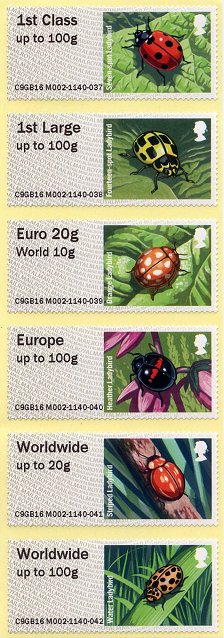 |
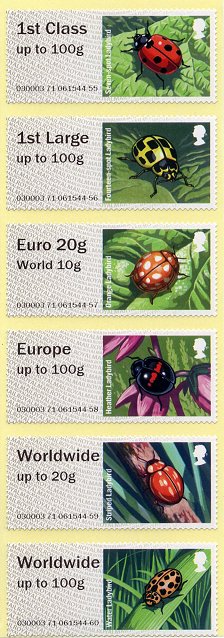 |
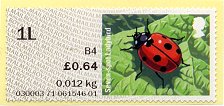 |
The 'Open value stamps' can be obtained from the NCR postal kiosks only, by selecting the 'Post an item' option from the main menu. These are variable value stamps, usually printed for immediate use, and include some details about the shipment type, postage rate, destination and weight of the item (see article, also published in VARIABLE 34).
The six 'open value stamps' of the central column corresponds to the six face value indicators programmed in the left set or 'Collectors Strip'.
Below, an NCR test imprint. |
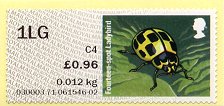 |
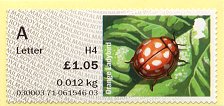 |
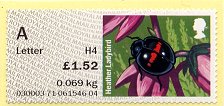 |
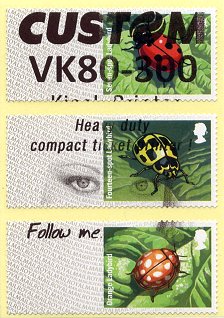 |
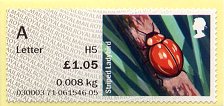 |
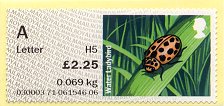 |
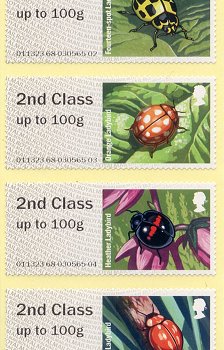 |
Although the rolls of the new thematic series were intended to be used for the issue of '1st Class' stamps only, some post offices installed them, voluntarily or by mistake, on the printer intended to issue '2nd Class' stamps ... |
| Edward VIII at The Postal Museum |
On January 20th 1936, after the death of his father King George V, Prince Edward acceded to the throne as Edward VIII. The new king abdicated on December 10th of the same year, without being crowned, and was succeeded by his brother Albert, who decided to use the name of George VI.
During this short reign only four stamps with Edward’s head were issued. The first three values were issued on September 1st, and the 1d on September 14th.
Coinciding with the 80th anniversary of the issue of this stamp and the opening of Autumn Stampex 2016, The Postal Museum decided to program a special overprint in its 'Post & Go +' kiosk, in memory of the eleven months of the reign of Edward VIII. |
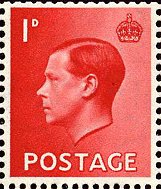 |
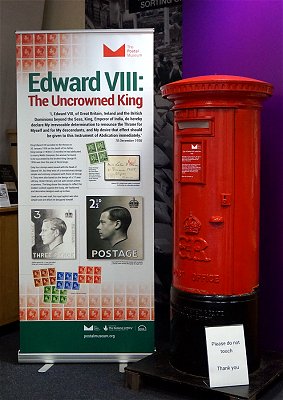 |
As on earlier occasions, the museum prepared a board with interesting information on the reign of Edward VIII and the stamps issued with his head. Next to the board, one of the only sixteen pillar boxes installed, bearing the Edward VIII cipher. |
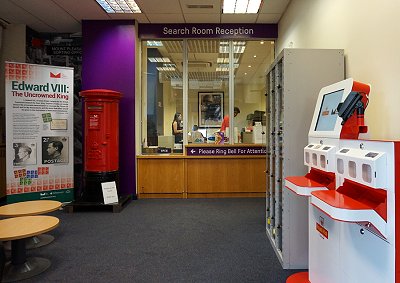 |
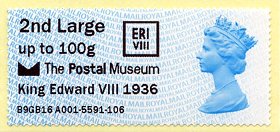 |
The new special overprint was available from September 14th to November 11th 2016. In addition to the usual museum logo, the imprint includes the text 'King Edward VIII 1936' and a graphic image with the royal cipher of Edward VIII (ERI VIII - Edwardvs VIII Rex Imperator), designed by himself and used in the royal mail. |
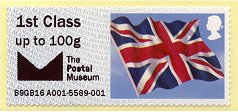 |
The modular 'Post & Go +' kiosk installed in the museum has six printers. Usually, four of the printers are used for stamp printing and two for receipts. In September 2016, the machine issued stamps with the 'Machin 1st Class', 'Machin 2nd Class', 'Union flag' and 'Mail coach, 1790s' design. The new special imprint was only program-med in the two 'Machin' designs, the only ones having enough free space to allow the inclusion of longer texts and graphic images. |
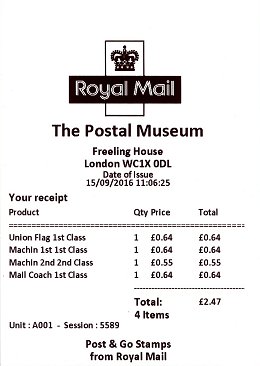 |
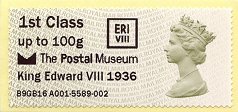 |
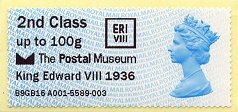 |
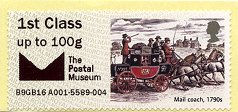 |
As usual, The postal Museum prepared special presentation packs and first day covers, with a reduced print run and very good acceptance by collectors.
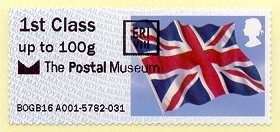 |
On the morning of October 24th, a careless software error, most likely caused by the introduction of the ‘Common Poppy’ design, included the special overprint on the ‘Union flag’ design. This error was available for a very short time. |
| Royal Mail marks Trafalgar Day ... one month before |
Since 2014, Royal Mail has been commemorating the Battle of Trafalgar through a temporary overprint on the 'Union flag' design, in some of its 'Post & Go' kiosks installed in Royal Navy museums. In 2014, it was only the A002 machine installed at The National Museum of the Royal Navy, in Portsmouth (see article, also published in VARIABLE 35).
In 2015, they added the A005 kiosk installed at The Royal Marines Museum, in Southsea (see article, also published in VARIABLE 39), and in 2016 there have already been five, the previous two plus the A006, A007 and A008 kiosks installed, a few months ago, in the HMS Trincomalee, the Explosion! Museum and HMS Caroline, respectively.
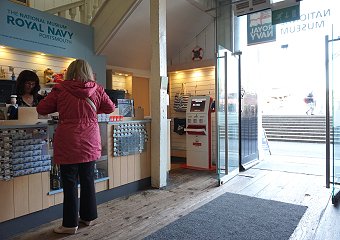 |
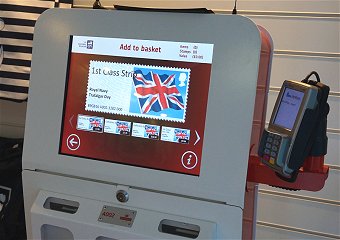 |
| A002 kiosk installed in the shop of The National Museum of the Royal Navy, Portsmouth |
Unlike the earlier years, this special imprint, in 2016, was scheduled one month before the anniversary. Trafalgar Day is celebrated on October 21st. However, the imprint was available in kiosks from September 23rd until October 23rd 2016.
| Royal Mail & 'Post & Go' at the Political Party Conferences |
In the United Kingdom, the main political parties hold their annual conferences during a recess period in the House of Commons, usually in September and October. Among the attendees to these conferences, in addition to delegates and political leaders, are dozens of companies, trade associations and lobbyists taking advantage of these events to make themselves known.
As far as our field of study is concerned, Royal Mail had in 2015 installed a stand with a 'Post & Go' kiosk at all three political conferences. Given that these events can only be accessed by members of the political parties and with the kiosk installed for operational - not philatelic - purposes, Royal Mail consequently so no reason to publish any information on these events.
| In 2016, Royal Mail again had a stand at the conferences of the three main UK political parties. The Labour Party held its conference from September 25th to 28th, in Liverpool. For its part, the Conservative Party held theirs from October 2nd to 5th, in Birmingham, and the Scottish National Party, from October 13th to 15th, in Glasgow. |
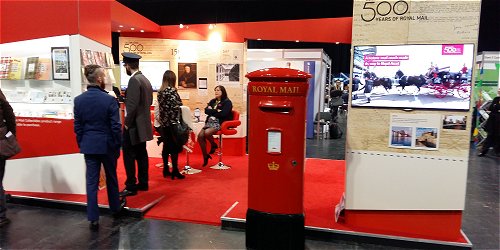 |
In all three locations, Royal Mail installed the M007 kiosk, with an additional unit with scales and various new options available from the main menu (see image below).
Thus, the first icon on the display showed the option of accessing the Internet, with a link to the Royal Mail Stamps & Collectibles page.
By selecting 'Post an Item', the user could obtain a variable value stamp for a letter or parcel, according to the weight and selected type of shipment.
The third icon allowed the printing of different types of self-adhesive postal labels (right image), including the sender's information, etc., which the customer could then stick on the package or letter. |
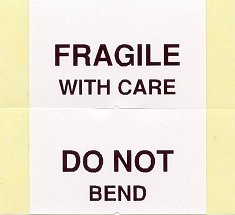 |
The first two icons in the second row are the most well-known to collectors, allowing the purchase of the usual variable value stamps with the 'Machin' definitive design and the 'Royal Mail Heritage: Transport' series.
Finally, the 'Smilers' icon offered the collector customized stamp sheets. |
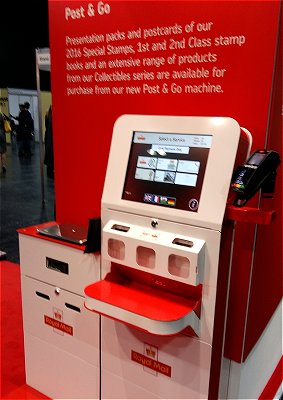 |
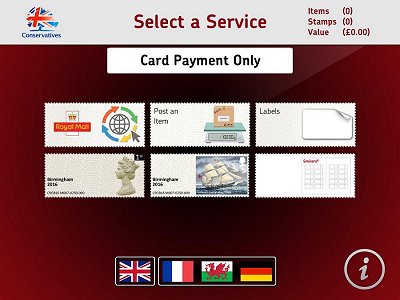 |
New to this 'Post & Go' kiosk were the variable value stamps obtained through the 'Post an Item' option which in this case were of the 'Open Value' type. These stamps included information about the shipment type, postage rate, and other details of the item, similar to those issued by the NCR postal kiosks.
And also, for the first time the kiosk issued a large size Horizon-type stamp for shipments weighing over 100 grams. This new variable value stamp with 2D code was gradually introduced at the NCR - SSK (Self - Service Kiosks) installed in the Post Office network from September 20th 2016 (article in preparation).
At the three conferences, the 'Machin' definitive design could be obtained with the six values of the usual sets or 'Collectors Strip'. The 'Royal Mail Heritage: Transport' series was only available with the basic value for domestic mail, i.e. '1st Class up to 100g'.
All variable value stamps issued by selecting the first two icons in the second row of the display include a special text referring to the city where the party conference was held - 'Liverpool 2016', 'Birmingham 2016' & 'Glasgow 2016'. Since it was an operational and not a philatelic kiosk the code at the bottom of the stamps begins with the letter 'C' instead of 'B'. |
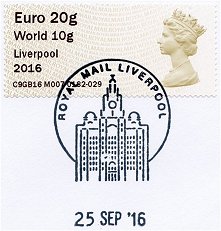 |
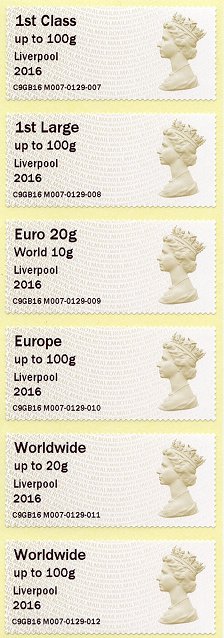 |
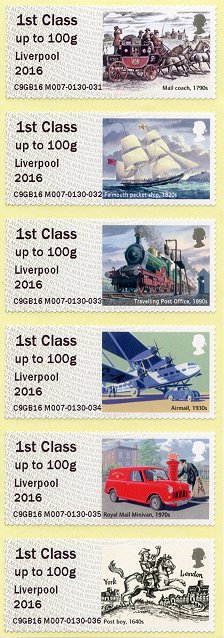 |
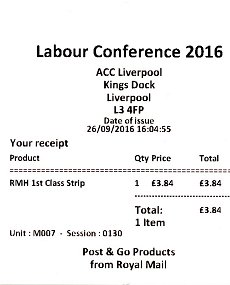 |
| Labour Party conference - 'Liverpool 2016' |
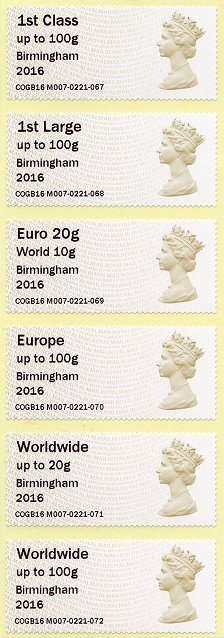 |
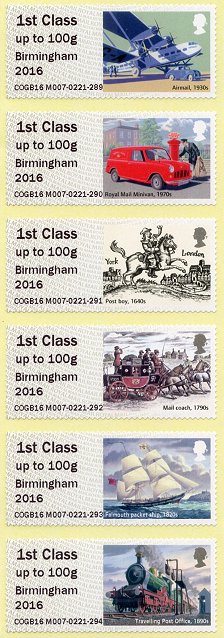 |
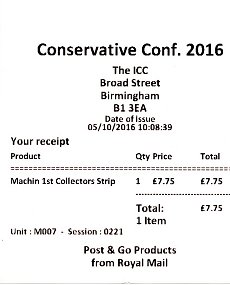 |
| Conservative Party conference - 'Birmingham 2016' |
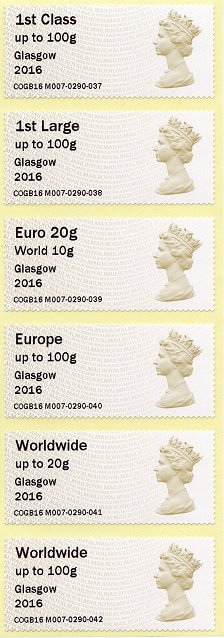 |
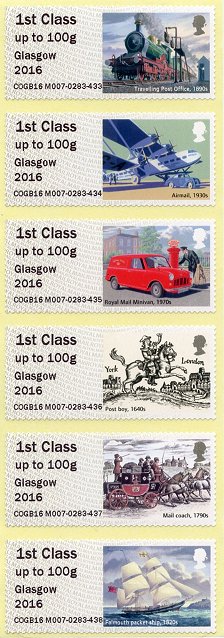 |
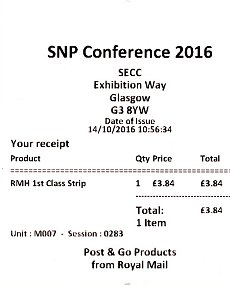 |
| Scottish National Party conference - 'Glasgow 2016' |
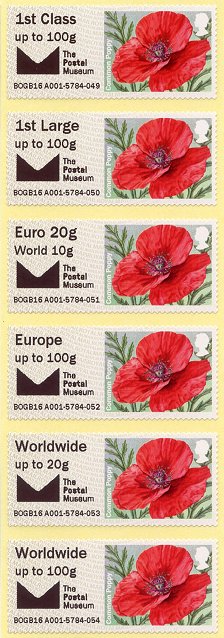 |
As in previous years, in 2016 Royal Mail temporarily reintroduced the 'Common Poppy' design, in commemoration of 'Remembrance Day'. This design was available, from October 24th to November 13th, at postal kiosks installed in Post Offices, Enquiry Offices, the London Postal Museum, and the Royal Navy Museums. |
| Many of these machines, such as the one installed in the postal museum, still had rolls of label stock from the previous year, with the code MA15. So only some kiosks used the new reprint for 2016. |
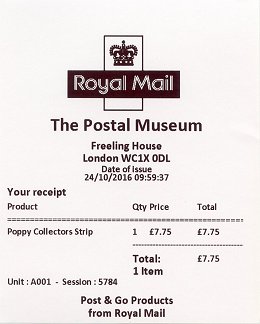 |
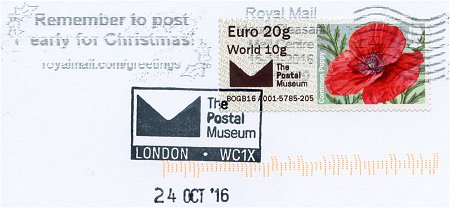 |
| A new kiosk for literature lovers |
The installation of postal kiosks in UK museums is continuing. On the 1st November 2016, Royal Mail installed another Intelligent AR kiosk in the small gift shop at Shakespeare's Birthplace Trust in Stratford-upon-Avon, south of Birmingham.
| The Shakespeare Birthplace Trust is an independent registered educational charity created in 1847. The Trust preserves and maintains the properties, documents and other objects related to the life and times of William Shakespeare. |
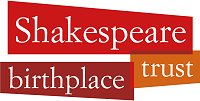 |
The shop (images below) is right next to the house where it is believed that the author was born in 1564, and spent his childhood years, now transformed into a museum. Other places and buildings related to his life and work can also be visited in the city.
In 2016, with the celebration of the 400th anniversary of Shakespeare's death, the properties, managed by the Shakespeare Birthplace Trust, received a total of 825,000 visitors. Possibly, because many of the visitors pass through the gift shop the installation of a postal kiosk in this location was deemed justified.
The machine installed at Stratford-upon-Avon is the A009 kiosk, first launched at London's Autumn Stampex 2015 and later temporarily used at other philatelic events in the United Kingdom and Hong Kong. |
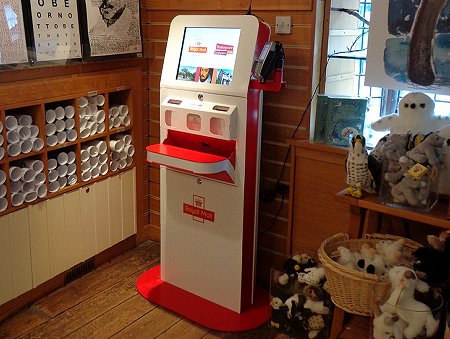 |
| On the date of installation, the 1st November 2016, the kiosk issued stamps with the 'Union flag' and 'Machin' designs. |
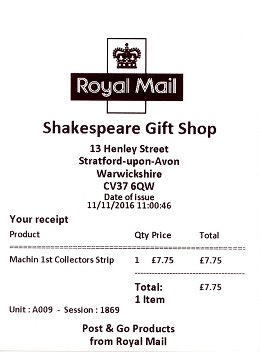 |
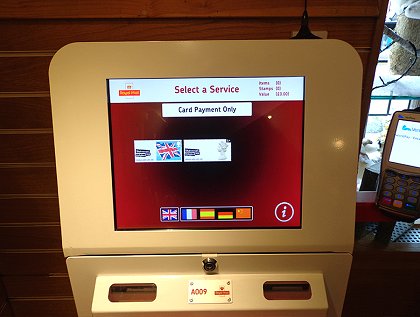 |
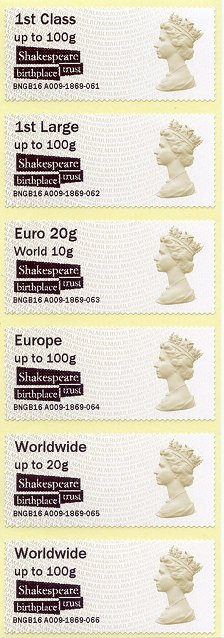 |
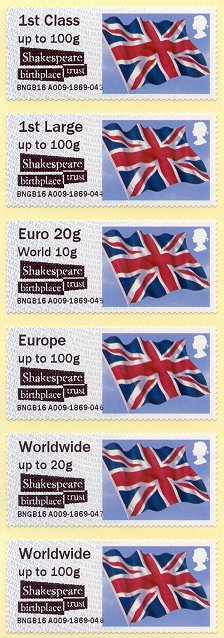 |
Instead of the name of the museum, the machine prints a graphic featuring the Trust's logo on all the stamps issued.
It's a pity that the label designs used in the kiosk do not have any kind of relevance to William Shakespeare or his work, which would quite possibly arouse more interest from visitors. |
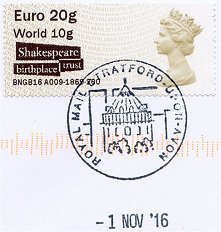 |
| The A011 kiosk in Blandford Camp |
Two days after the installation of the kiosk in Stratford-upon-Avon, another Post and Go machine went operational in a military museum, The Royal Signals Museum, in Blandford Camp, Blandford Forum, Dorset, in the south of England.
The Royal Signals Museum is the communications museum of the British Army and the exhibits depict the importance of communications in the wars and campaigns of the last 150 years.
The museum was created in the mid-30's, and since 1967 is located in Blandford Camp. This large military camp is currently home to The Royal Corps of Signals, one of the combat support arms of the British Army.
The new museum building (images below) was inaugurated in 1997. |
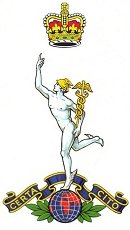 |
The kiosk was installed on 3rd November 2016 in the souvenir shop located at the entrance to the museum. It is the A011 kiosk, first used a few months earlier at the 2016 Perth's Scottish Congress and which then moved to New York for the World Stamp Show.
The museum has very few visitors. Blandford Camp is situated in the Dorset countryside, a somewhat remote place with difficult access by public transport. It is within the perimeter of a military base so all adults must be identified at the guardroom and obtain a pass. However, the kiosk is also used by the military personnel, many of whom frequently visit the the museum cafeteria.
| Like other museum kiosks, on the date of installation, the machine issued stamps with the 'Union flag' and 'Machin' definitive designs. |
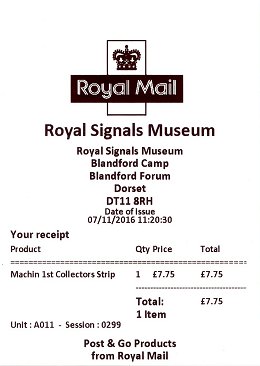 |
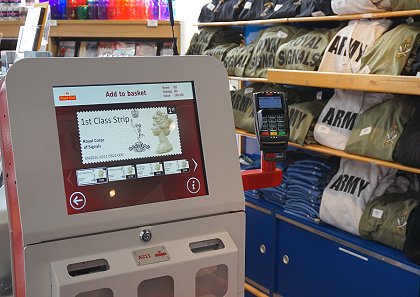 |
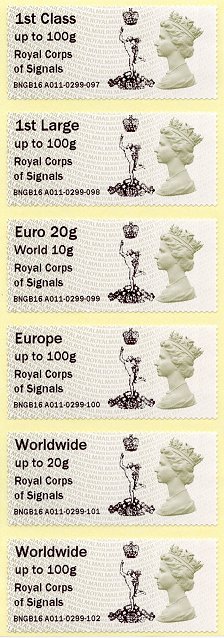 |
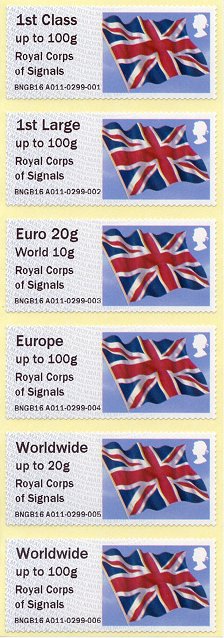 |
All the stamps issued by the kiosk include the location identifier, 'Royal Corps of Signals'.
With more space for imprints the 'Machin' design also includes a graphic design featuring the cap badge or emblem of The Royal Corps of Signals - Mercury, the winged messenger of the gods (see image at the beginning of the article). |
| |
| 2016. Hibernating Animals |
The final thematic series of the year was issued on 14th November 2016, at the beginning of the Christmas season. It is the third special issue dedicated to the winter flora and fauna of the United Kingdom. The 2014 set illustrated winter plants, the 2015 series featured animals active during the winter and the 2016 designs are dedicated to hibernating animals.
Like the previous issues, the new set also consists of four designs, two with the blue background for economy or '2nd Class' stamps, and two in grey for priority or '1st Class' mail.
The set could be obtained at many of the NCR - 'Post & Go' postal kiosks installed in post offices across the country, during the Christmas season. It was also available from the Intelligent AR kiosks permanently installed in the London Postal Museum and the Royal Mail Enquiry Offices (images below).
Royal Mail released its usual presentation pack with the four designs (right image), printed by the C002 internal-usage printer. |
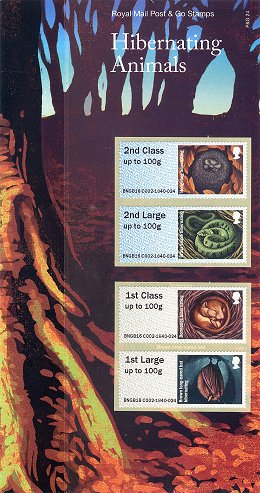 |
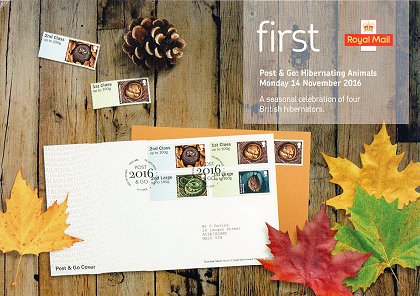 |
|
The two designs for '2nd Class' stamps feature the Hedgehog and the Grass snake (Natrix natrix), and the two designs for '1st Class' stamps are dedicated to the Dormouse and the Brown long-eared bat (Plecotus auritus). |
The rolls of labels were manufactured by International Security Printers, and have identical characteristics to previous issues.
The four images are designs by Osborne Ross based on illustrations by Chris Wormell.
Pictorial first day of issue postmarks |
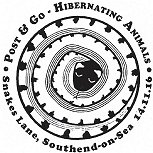 |
 |
 |
 |
Presentation packs include four stamps with face values corresponding to the two basic postage rates for domestic economy mail ('2nd Class' & '2nd Large') and priority mail ('1st Class' & '1st Large'). However, the lower identification code is the same for the four stamps - BNGB16 C002-1840-024. In the first block, B is for 'philatelic' issue, N is for the month of issue (November), GB for the country, and 16 for the year of issue. In the second block, C002 is the code of the printer. Then follows 1840, the usual fictitious session number, and 024 is the number of the pictorial series, from the beginning of the 'Post & Go' issues.
| The following images show the 'Collectors strip', or the sets of stamps with the face value indicators available for this set, issued by the equipment in service on the date of issue. The '2nd Class Collectors Strip' includes two values for economic mail, and the 'Collectors strip' includes the six usual values for priority or '1st Class' mail. |
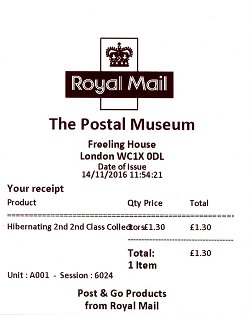 |
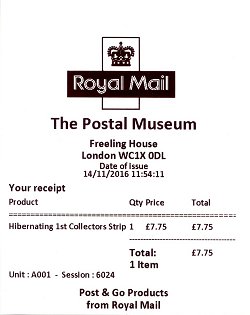 |
| First day of issue receipts for the two 'Collectors Strip', postal kiosk A001 installed in the London postal museum |
Postal kiosks
NCR
(Post Offices) |
Postal kiosks
Intelligent AR
(Royal Mail Enquiry Offices) |
Kiosk
Intelligent AR
(The Postal Museum) |
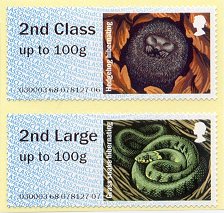 |
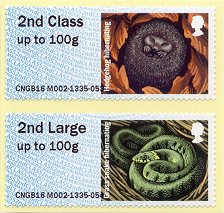 |
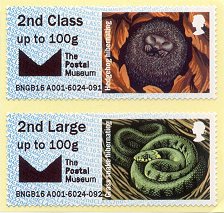 |
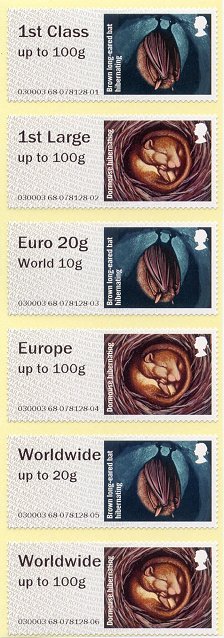 |
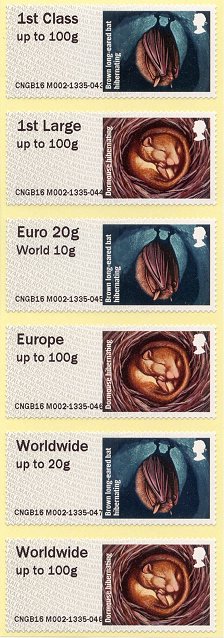 |
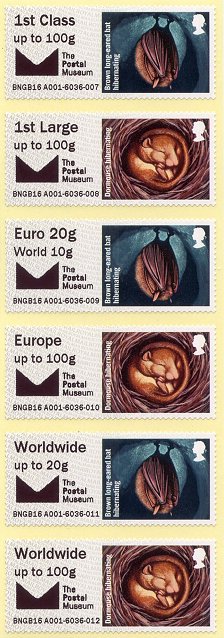 |
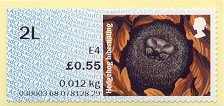 |
The 'Open value stamps' can be obtained from the NCR postal kiosks only by selecting the 'Post an item' option from the main menu. These are variable value stamps, usually printed for immediate use and include some details about the shipment type, postage rate, destination and weight of the item (see article, also published in VARIABLE 34).
The four 'open value stamps' in the images on the left correspond to the first postage rates for economy and priority mail, 2L - '2nd Class up to 100g' & 1L - '1st Class up to 100g'.
The image on the right depicts a test imprint strip produced by the printers installed in NCR kiosks. |
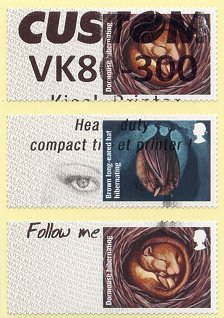 |
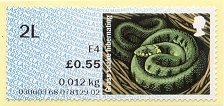 |
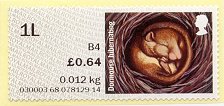 |
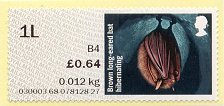 |
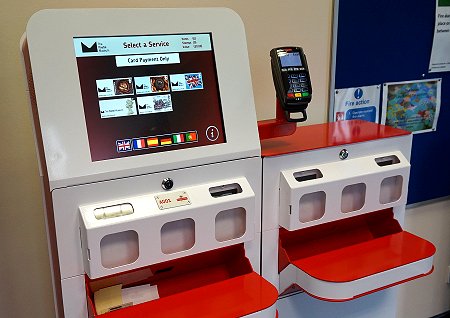 |
The 'Hibernating Animals' series was available from the kiosk installed in The Postal Museum until 30th December 2016. All the stamps included the graphic of the museum's logo, introduced in February 2016 (see article, and in VARIABLE 40).
During this period five of the six printers of the A001 kiosk were dedicated to printing stamps ('Hibernating Animals 1st and 2nd Class', 'Union flag', 'Machin 1st' and 'Mail coach'), and the sixth to printing receipts. |
| Royal Mail marks a milestone in military aviation |
 |
On December 3rd 1945, Lieutenant-Commander Eric Melrose 'Winkle' Brown made the first landing and takeoff aboard an aircraft carrier by a jet-powered aircraft. The airplane used for the test was the LZ551/G, the second of the three prototype DH.100's produced by de Havilland in 1944, and named 'Sea Vampire'.
This aircraft is currently in the collection of the Fleet Air Arm Museum, in Yeovilton, Somerset. |
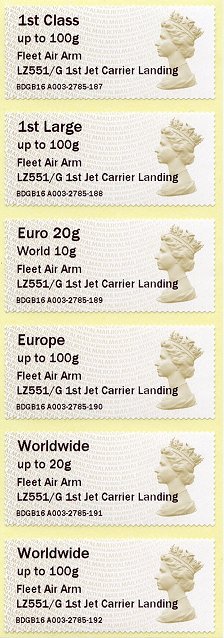 |
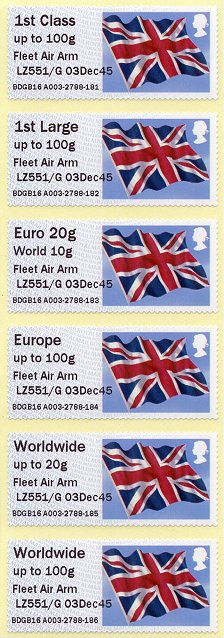 |
Captain Brown was the test pilot who flew the most types of aircraft throughout his career and holds the world record for the most aircraft carrier deck take-offs and landings, and is the Royal Navy's most decorated pilot.
In the year of the death of this great aviator, the Fleet Air Arm Museum and Royal Mail marked the 71st anniversary of this milestone in military aviation with the addition of a temporary commemorative text on the stamps issued by the A003 kiosk installed in the Museum (see article, also published in VARIABLE 37).
From December 3rd 2016, and for one month, all stamps issued with the 'Machin' design included the special imprint ‘LZ551/G 1st Jet Carrier Landing’ under the permanent museum identifier. The stamps issued with the 'Union flag' design, having less free space for imprints, included the text ‘LZ551/G 03Dec45’. |
ATM Web - Spain and Latin American Postal Services: http://www.ateeme.net
© J. Jove - ATEEME. Variable value stamps study group. All rights reserved
This page was created in September 2016 and last updated:
12.08.17
. English edition last rewritten by S. Goodman & J. Gareze (12.02.2017)
|













